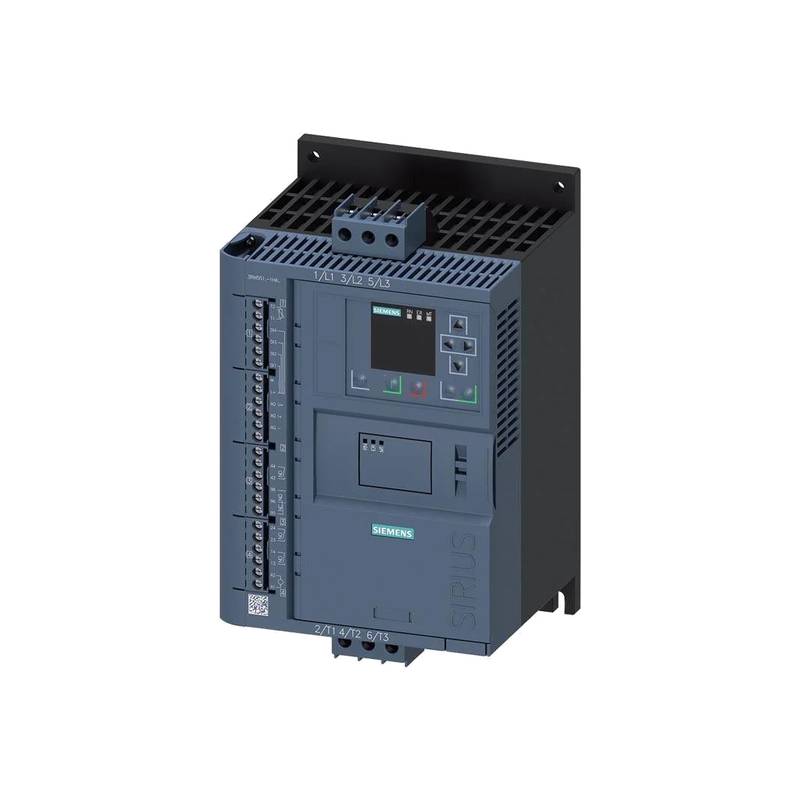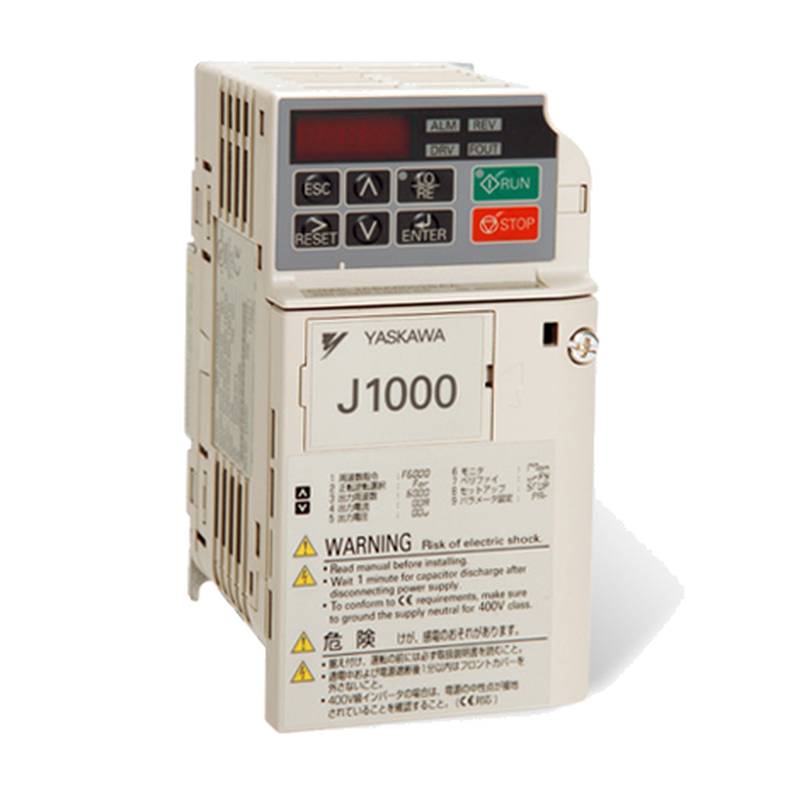
The Siemens 7KT1654 AC Energy Meter Power Instrument is a sophisticated device designed for precise measurement and monitoring of electrical energy consumption in single-phase systems. Engineered for reliability and accuracy, this meter provides essential data for effective energy management, billing, and system diagnostics. Its robust design and advanced features make it a valuable component in industrial, commercial, and residential applications where accurate power measurement is critical.
Product Specifications
| Feature | Specification |
| :------------------------ | :--------------------------------------------------------------------------------------------------------- |
| Product Designation | SENTRON 7KT PAC1600 |
| Type | Single-phase AC Energy Meter |
| Nominal Current (In) | 63 A |
| Maximum Current (Imax) | 63 A |
| Nominal Voltage (L-N) | 187 - 264 V AC |
| Nominal Voltage (L-L) | 323 - 456 V AC |
| Frequency Range | 45 - 66 Hz |
| Display Type | LCD (Liquid Crystal Display) |
| Measurement Capabilities | Apparent energy, Active energy, Reactive energy, Voltage, Current, Frequency |
| Communication Protocol | M-Bus + MID |
| Transfer Rate | Minimum: 300 kbit/s, Maximum: 38,400 kbit/s |
| Protection Class (Front) | IP40 |
| Protection Class (Rear) | IP20 |
| Operating Temperature | -25°C to +55°C |
| Mounting Type | Standard DIN rail |
| Power Consumption | Typically 0.4 W (active power) |
| Supply Voltage | Self-powered |
| Calibration Compliance | Measuring Instruments Directive (MID) |
| Standards Compliance | IEC62053-21, IEC62053-23 |
| Housing Depth | 63 mm |
| Country of Origin | Italy |
Core Features & Market Positioning
The Siemens 7KT1654 stands out in the energy meter market due to its combination of MID compliance, comprehensive measurement capabilities, and integrated M-Bus communication. This positions it as a reliable solution for applications requiring certified accuracy for billing purposes, such as in commercial buildings and industrial facilities. The ability to measure apparent, active, and reactive energy provides a complete picture of power consumption, enabling more sophisticated energy management strategies. Unlike basic meters, the 7KT1654 offers detailed insights into power quality through its frequency and voltage measurement functions, differentiating it from simpler alternatives. Its self-powered design and standard DIN rail mounting simplify installation and integration into existing electrical panels, further enhancing its market appeal for industrial automation and energy monitoring systems.
Key Application Scenarios
The Siemens 7KT1654 is exceptionally versatile, finding critical applications across various sectors:
Industrial Facilities: For monitoring energy consumption of individual machines, production lines, or entire factory sections to optimize operational efficiency and reduce costs. Its precise measurement supports predictive maintenance by identifying unusual energy patterns. Commercial Buildings: Ideal for sub-metering in office buildings, retail spaces, or multi-tenant complexes to allocate energy costs accurately to different tenants or departments, ensuring fair billing and encouraging energy conservation. Residential Complexes: Used for billing in apartment blocks or shared housing, providing transparent energy usage data for each unit. Renewable Energy Integration: Can be employed to monitor energy exported to or imported from the grid, crucial for facilities utilizing solar or wind power generation. Data Centers: For detailed monitoring of power usage effectiveness (PUE) and precise allocation of energy costs for critical IT infrastructure.
Practical System Integration Guidance
Integrating the Siemens 7KT1654 into an existing system is streamlined due to its standard DIN rail mounting and self-powered operation. For system integration, the M-Bus communication interface is a key feature, allowing seamless data exchange with building automation systems or energy management platforms. The M-Bus protocol enables the meter to transmit measured data, including energy values, voltage, current, and frequency, to a central data logger or supervisory control and data acquisition (SCADA) system for analysis and reporting. The transfer rate for M-Bus communication ranges from 300 kbit/s to 38,400 kbit/s, accommodating various system requirements. When connecting, ensure that the supply voltage to the meter falls within its operating range of 187-264 V AC (L-N). For comprehensive wiring diagrams and specific connection instructions, always refer to the official Siemens technical documentation.
Operation and Risk Mitigation
Operating the Siemens 7KT1654 is straightforward, primarily involving configuration via its LCD display and single button. Users can navigate through measured values and basic settings. Risk mitigation in its operation focuses on adherence to electrical safety standards. The meter operates within a specified voltage range (187-264V AC L-N) and current limit of 63A. It is crucial to ensure that the power supply is switched off before installation or maintenance to prevent electric shock. The device's IP40 rating on the front and IP20 on the rear signifies protection against solid objects, but not against moisture, necessitating installation in a dry, protected environment. Regular checks for physical damage and ensuring correct wiring are vital for safe and reliable operation. Always consult the user manual for detailed safety precautions and troubleshooting guidance.
Scalability & Long-Term Value
The Siemens 7KT1654 offers significant long-term value through its robust performance and integration capabilities. Its compatibility with Siemens' broader SENTRON PAC series and energy management software like powermanager allows for scalable solutions. Facilities can start with a single 7KT1654 for basic monitoring and expand their system by adding more meters or integrating with advanced Siemens platforms for comprehensive energy analytics and IIoT connectivity. The M-Bus interface facilitates easy data aggregation from multiple devices, making it adaptable to growing energy monitoring needs without requiring complete system overhauls. This future-proofing ensures that the investment in the 7KT1654 remains relevant as energy management strategies evolve towards more digitalized and connected infrastructures.
Frequently Asked Questions (FAQs)
Q1: What is the primary function of the Siemens 7KT1654 AC Energy Meter?
The Siemens 7KT1654 is an advanced single-phase AC energy meter designed for precise measurement of electrical energy. It records apparent, active, and reactive energy consumption, providing vital data for billing and energy management. Its robust feature set supports accurate monitoring in various industrial and commercial settings.
This meter offers critical insights into power usage, enabling users to identify consumption patterns and potential savings. Its accuracy ensures reliable data for financial settlements and operational efficiency assessments.
The 7KT1654 also measures voltage, current, and frequency, offering a comprehensive overview of electrical parameters. This functionality goes beyond simple energy counting, providing valuable diagnostics for electrical systems.
Q2: What are the key technical specifications of the Siemens 7KT1654?
Key specifications include a nominal current of 63A and a voltage range of 187-264V AC (L-N). It features an LCD display for clear readings and is designed for standard DIN rail mounting. The meter supports M-Bus communication for data transfer.
It measures apparent, active, and reactive energy, ensuring comprehensive monitoring capabilities. The operating temperature ranges from -25°C to +55°C, suitable for most industrial environments.
The device is self-powered and boasts MID compliance for certified measurements. Its IP40 protection rating on the front makes it suitable for panel installations.
Q3: What types of energy can the Siemens 7KT1654 measure?
The Siemens 7KT1654 is capable of measuring apparent energy, active energy, and reactive energy. This complete suite of measurements allows for detailed analysis of electrical power flow and consumption.
Active energy is the actual power consumed, often measured in kilowatt-hours (kWh). Apparent energy accounts for both real and reactive power, while reactive energy is necessary for certain electrical equipment to operate.
Understanding these different energy types is crucial for optimizing power factor, managing demand charges, and ensuring efficient energy utilization across the installation.
Q4: How does the Siemens 7KT1654 communicate data?
The Siemens 7KT1654 utilizes the M-Bus (Meter-Bus) protocol for data communication. This is a standard serial communication protocol commonly used for energy meters.
The M-Bus interface allows the meter to transmit its measured data, such as energy consumption, voltage, and current, to a central data collection system or building management system. The transfer rate supports up to 38,400 kbit/s for efficient data exchange.
This communication capability is vital for remote monitoring, automated data logging, and integration into larger energy management or SCADA systems, enabling real-time insights and control.
Q5: Is the Siemens 7KT1654 suitable for billing purposes?
Yes, the Siemens 7KT1654 is highly suitable for billing purposes as it is MID-certified. The Measuring Instruments Directive (MID) ensures that the meter meets stringent accuracy and reliability standards required for legal trade and billing in Europe and other regions that recognize this directive.
Its precise measurement of active energy, often referred to as kWh, forms the basis for accurate electricity billing. The MID compliance provides an independent verification of its performance.
This certification assures users that the energy data recorded by the 7KT1654 can be reliably used for financial transactions, providing transparency and fairness in energy cost allocation.
Q6: What are the installation requirements for the Siemens 7KT1654?
The Siemens 7KT1654 is designed for standard DIN rail mounting, simplifying its installation within electrical panels or distribution boards. It is a self-powered device, meaning it draws power from the measured circuit, eliminating the need for a separate auxiliary power supply.
Before installation, ensure the power supply to the circuit is de-energized to prevent electric shock. The meter's front panel has an IP40 protection rating, suitable for protected environments, while the rear has IP20.
Always refer to the official Siemens installation manual for detailed wiring diagrams and safety procedures to ensure correct and safe implementation.
Q7: What is the operating temperature range of the Siemens 7KT1654?
The Siemens 7KT1654 operates reliably within a temperature range of -25°C to +55°C. This wide operational temperature range makes it suitable for various environmental conditions found in industrial and commercial installations.
Operating the meter within these specified limits ensures the accuracy and longevity of the device. Extreme temperatures outside this range could potentially affect performance or cause damage.
Proper ventilation should be considered when installing the meter, especially in enclosed panels, to help maintain optimal operating temperatures and prevent overheating.
Q8: Can the Siemens 7KT1654 be integrated with other Siemens energy management systems?
Yes, the Siemens 7KT1654 is designed for easy integration with Siemens' energy management solutions, such as the powermanager software. Its M-Bus communication interface facilitates seamless data exchange.
By integrating with powermanager or other compatible systems, users can achieve centralized energy monitoring, analysis, and reporting across multiple devices and locations. This enhances transparency and aids in cost reduction strategies.
This compatibility ensures that the 7KT1654 can be a part of a scalable and future-proof energy management infrastructure, supporting digital transformation and IIoT initiatives.
Q9: What are the safety considerations when installing and operating the Siemens 7KT1654?
Safety is paramount. Always de-energize the circuit before installation or any maintenance work to avoid the risk of electric shock. Ensure proper grounding and that all connections are made according to the wiring diagram.
The meter has IP40 (front) and IP20 (rear) ratings, indicating it should be installed in a dry, protected environment away from moisture and dust. Qualified personnel familiar with electrical safety regulations must perform the installation.
Refer to the Siemens manual for detailed safety instructions, including potential hazards like hazardous voltage and equipment damage due to improper fusing or condensation.
Q10: What advantages does the Siemens 7KT1654 offer over simpler energy meters?
The Siemens 7KT1654 offers several advantages, including MID certification for billing accuracy. It measures not only active energy but also apparent and reactive energy, providing a more complete power analysis.
Its integrated M-Bus communication allows for straightforward data collection and integration into automated systems, unlike meters relying solely on visual readings. The device is also self-powered, simplifying installation.
Furthermore, its comprehensive measurement capabilities and inclusion in Siemens' broader energy management ecosystem (like powermanager) offer greater scalability and long-term value compared to basic, standalone meters.
























